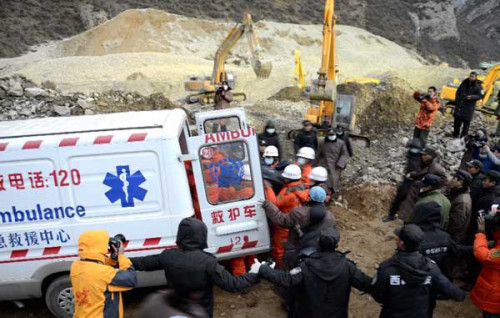
Firefighters carry bodies of two miners at the site where a large-scale landslide hit a mining area in Maizhokunggar County of Lhasa, southwest China's Tibet Autonomous Region, March 30, 2013.(Xinhua/Purbu Zhaxi)
Local villagers have also tried to send hot food to the rescuers.
Some 3,500 rescuers, 300 large-scale pieces of machinery, 10 sniffer dogs and 20 life detectors, have been mobilized at the site, according to the rescue headquarters.
"No life signs have been detected after the search via life detectors,snigger dogs and other technological means," said Li Yuelin, a rescue expert from northwestern Gansu Province.
Around 2 million cubic meters of rock and earth was set loose by the landslide, with the material taking up a length of more than three km and a depth ranging from 20 meters to 50 meters, according to Li.
Wang Zenghua, a senior leader of Tibet Autonomous Region's firefighting authorities, said the difficulties in the rescue operation were unprecedented in his 25 years of work in the region.
"The large volume of rock and mud displaced miners' tents, making it impossible to locate the missing," he said. "Completing the excavation and removal of debris is also unlikely in a short time given its depth."
As of 6 p.m. on Sunday, around 1.05 million cubic meters of debris had been combed.
"We will carry out an in-depth investigation into the exact cause of the landslide," promised Yang Dongliang, head of the State Administration of Work Safety, who arrived at the landslide site on Saturday.
Yang said the probe had begun and the final results will be made public. Experts with the Ministry of Land and Resources and the regional government have arrived at the scene.
"As long as there is a glimmer of hope, we will never give up our rescue efforts," said Yang.

Copyright ©1999-2011 Chinanews.com. All rights reserved.
Reproduction in whole or in part without permission is prohibited.